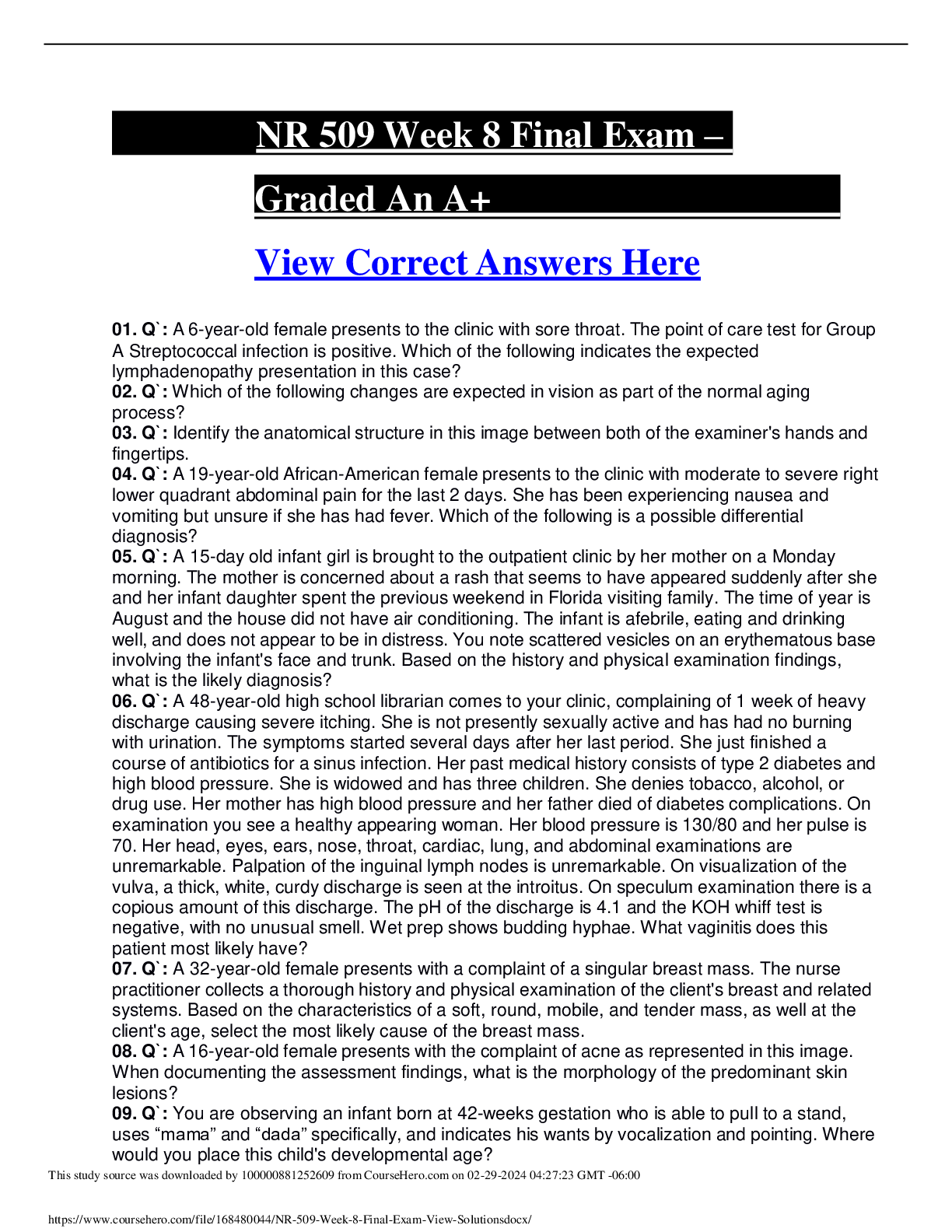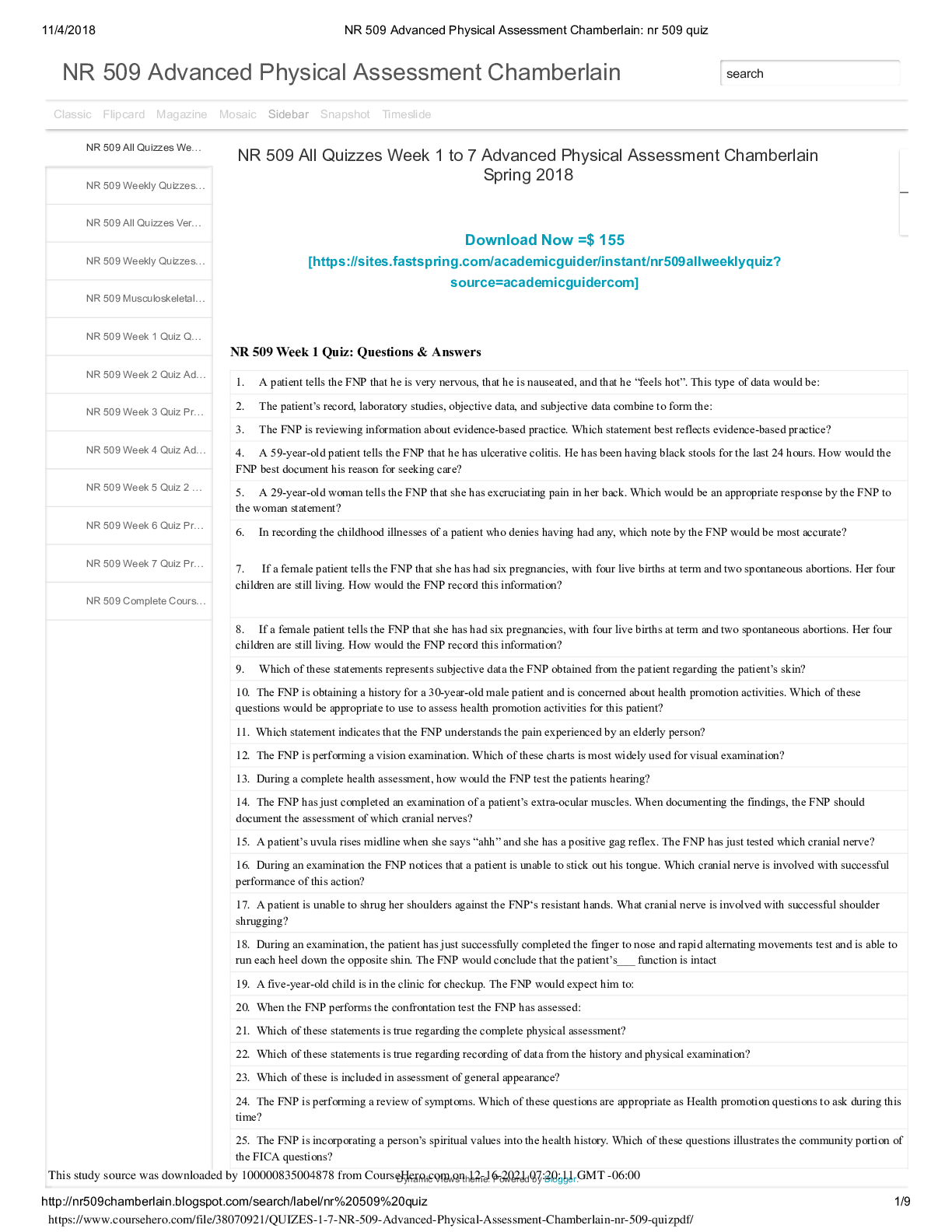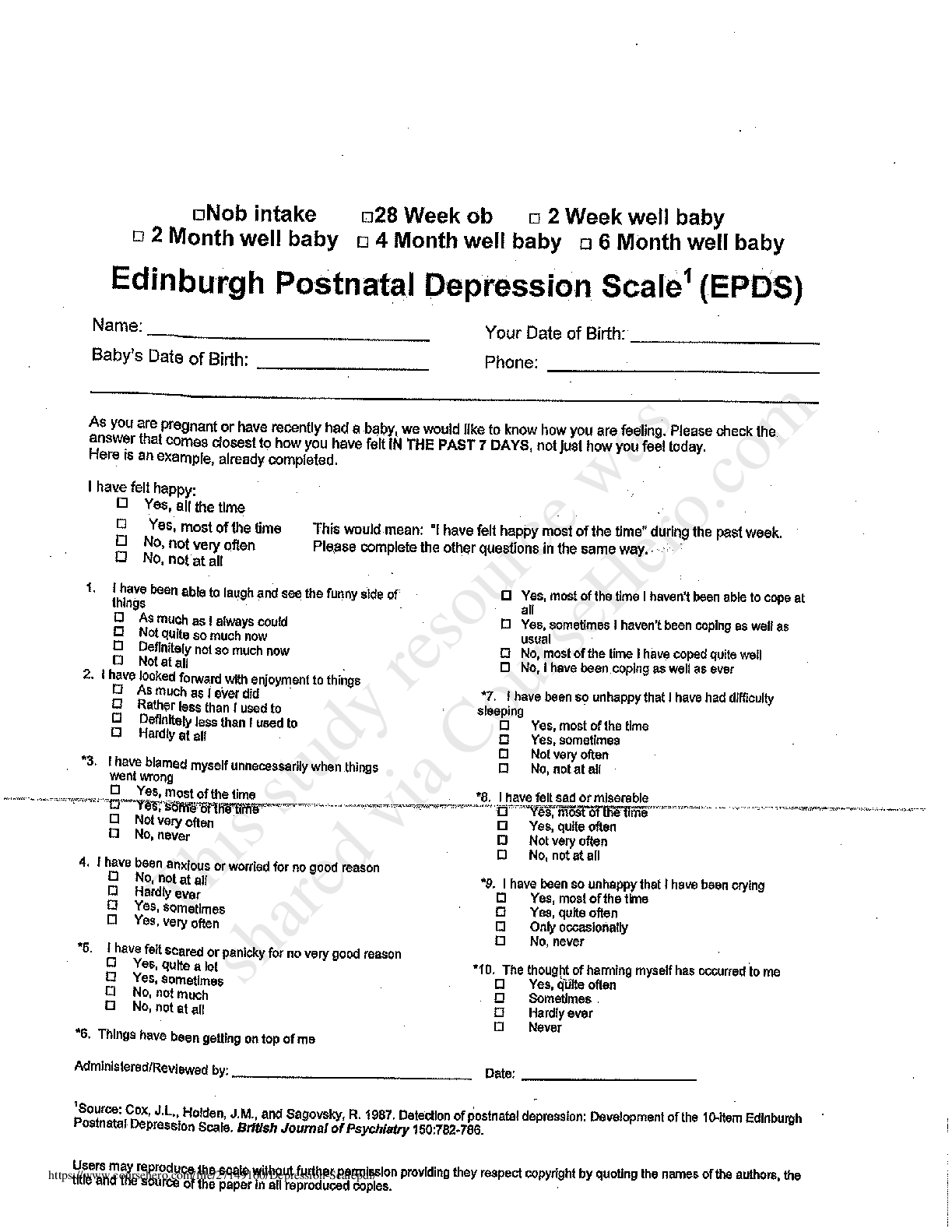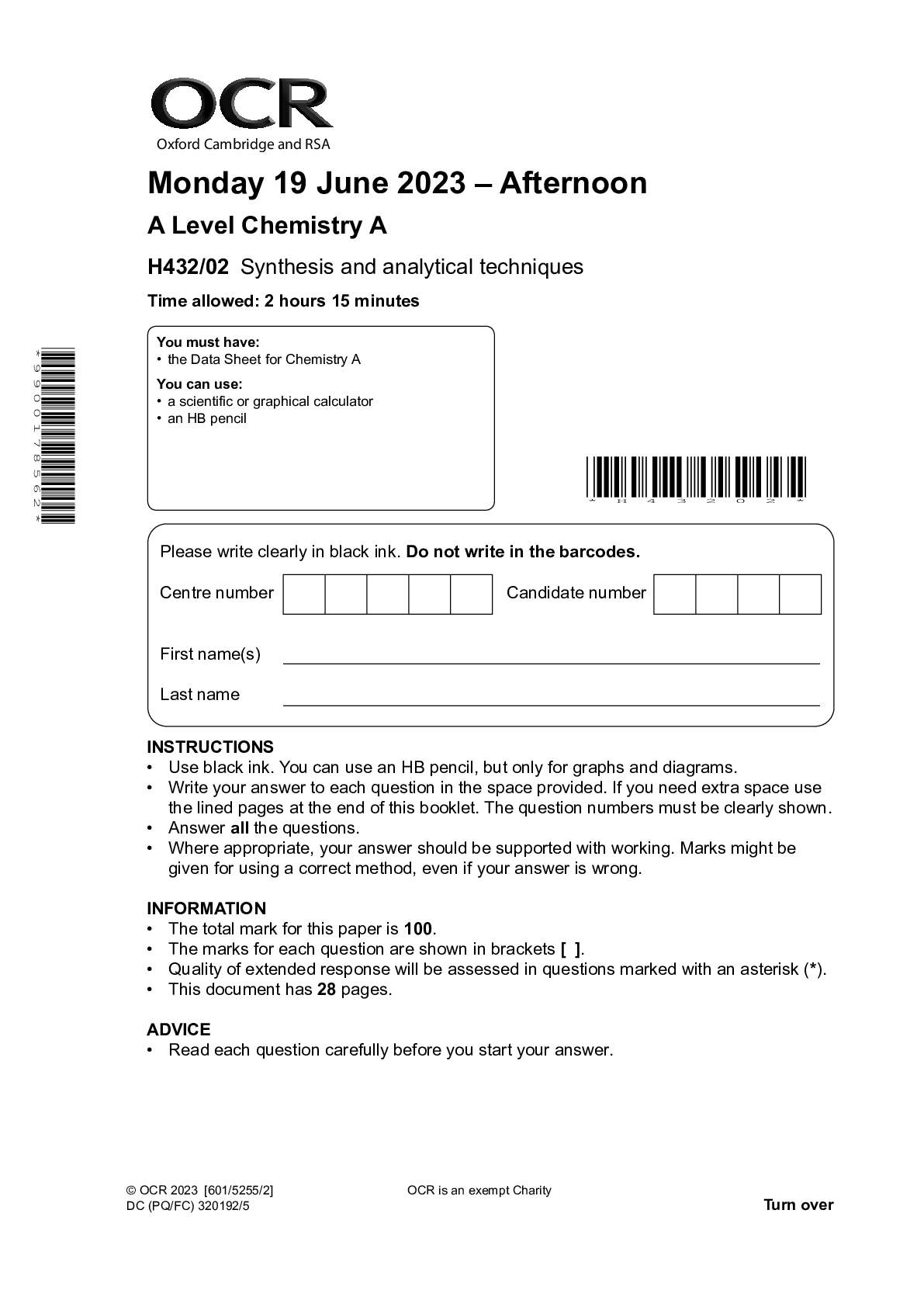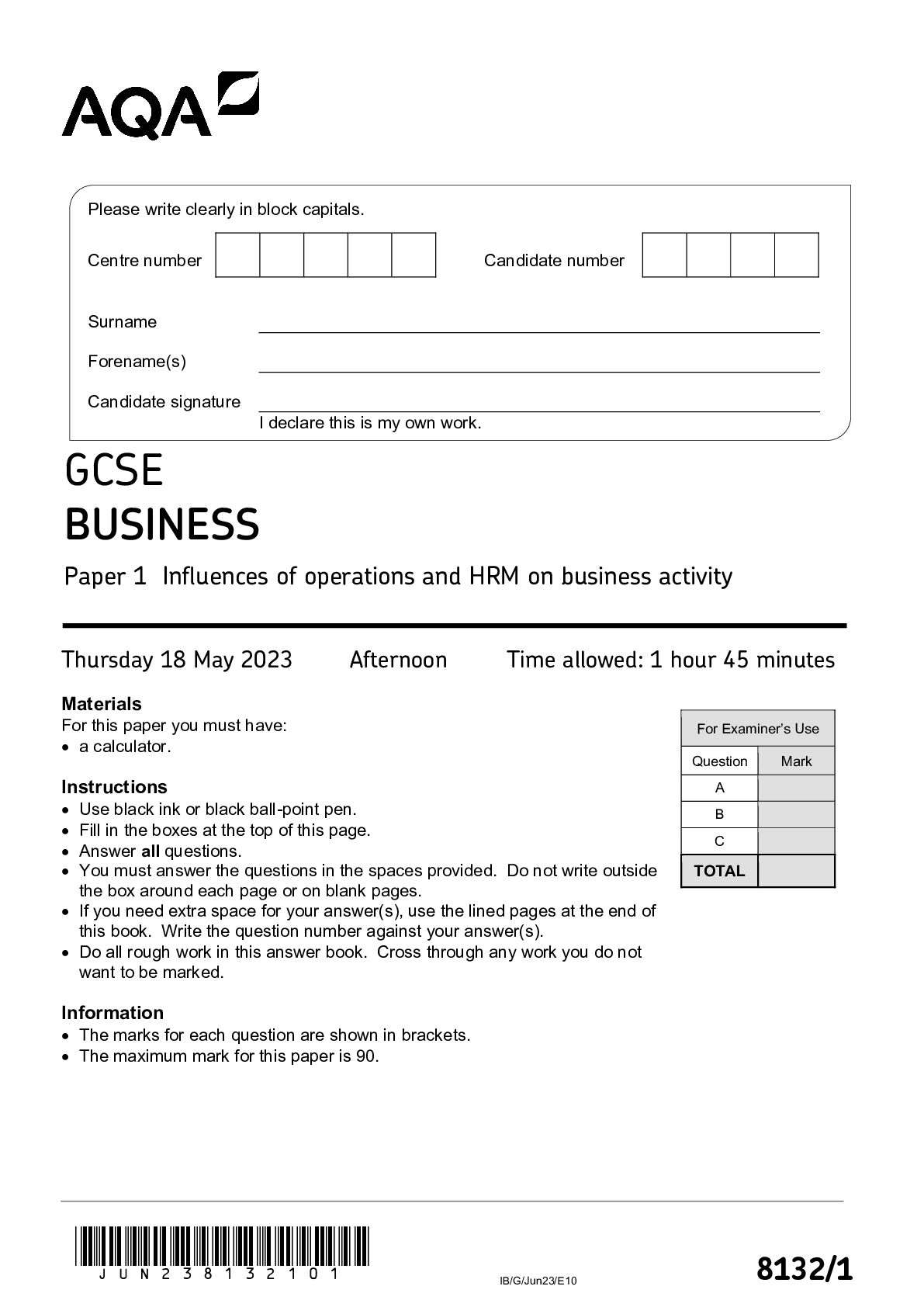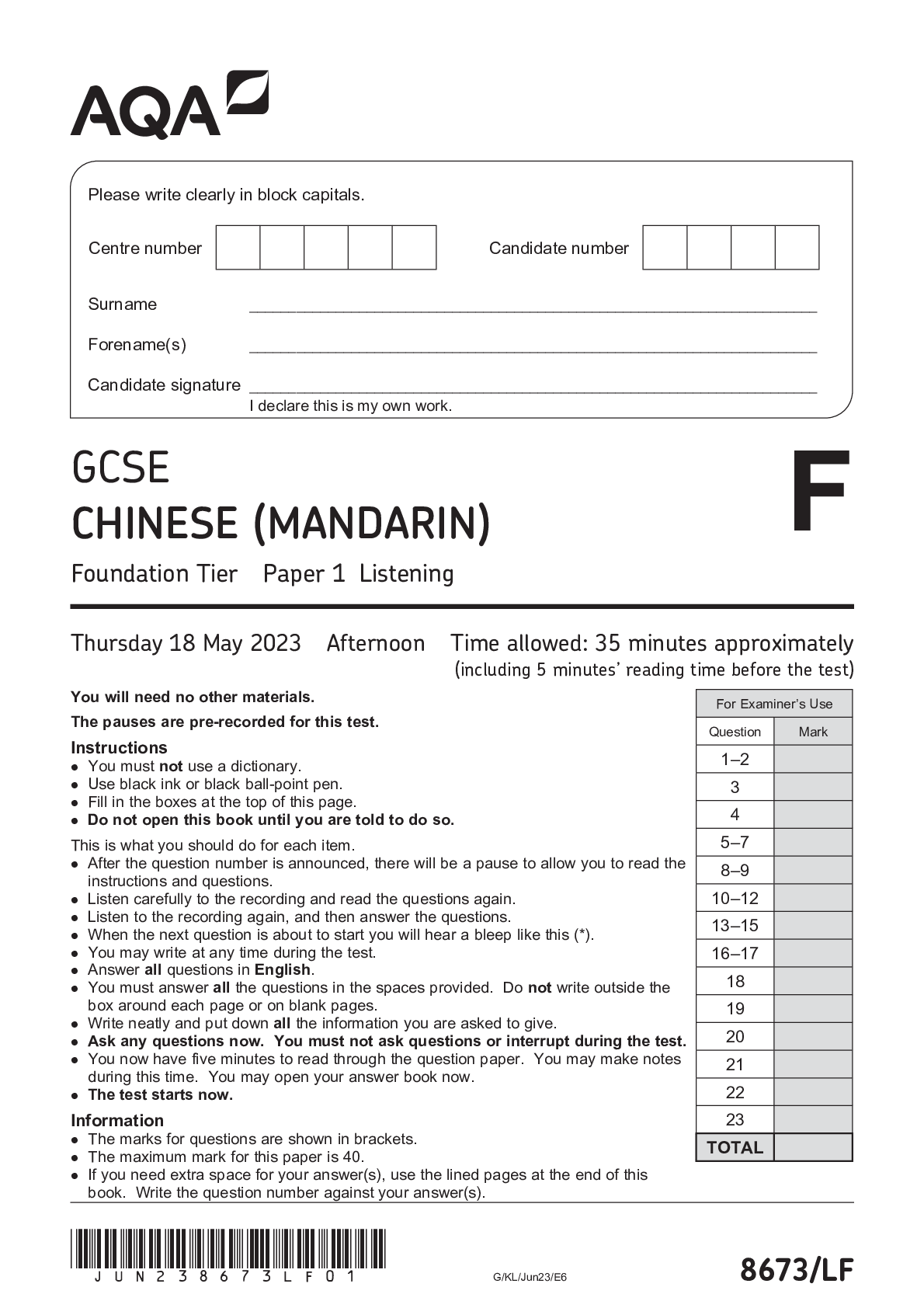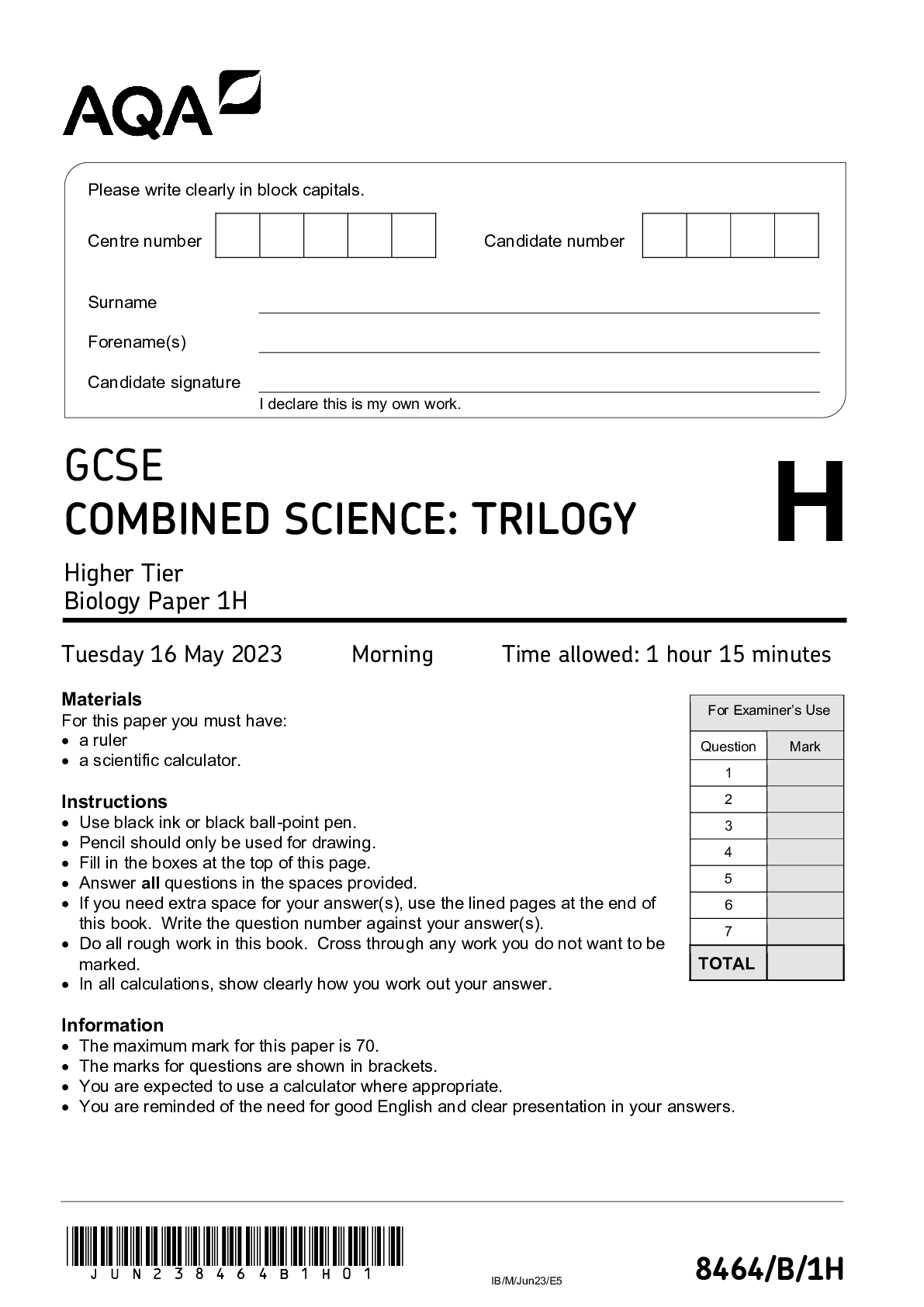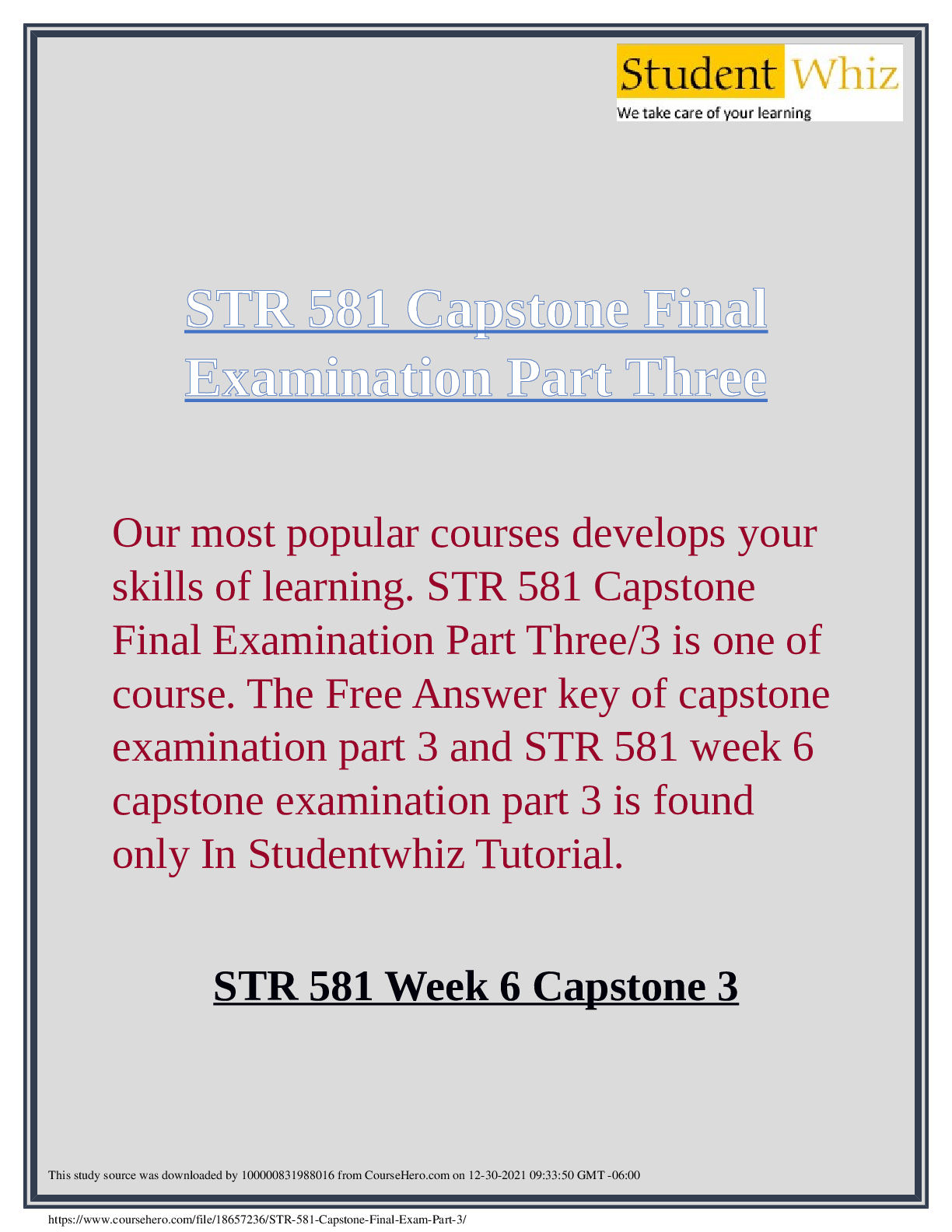*NURSING > QUESTION PAPER (QP) > NR 509 Advanced Physical Assessment – Download to Get An A+ (All)
NR 509 Advanced Physical Assessment – Download to Get An A+
Document Content and Description Below
NR 509 Advanced Physical Assessment – Download to Get An A+ Classic Flipcard Magazine Mosaic Sidebar Snapshot Timeslide NR 509 All Quizzes We… NR 509 Weekly Quizzes… ... NR 509 All Quizzes Week 1 to 7 Advanced Physical Assessment Chamberlain Spring 2018 NR 509 All Quizzes Ver… NR 509 Weekly Quizzes… NR 509 Musculoskeletal… Download Now =$ 155 [https://sites.fastspring.com/academicguider/instant/nr509allweeklyquiz? source=academicguidercom] NR 509 Week 1 Quiz Q… NR 509 Week 1 Quiz: Questions & Answers NR 509 Week 2 Quiz Ad… NR 509 Week 3 Quiz Pr… NR 509 Week 4 Quiz Ad… NR 509 Week 5 Quiz 2 … NR 509 Week 6 Quiz Pr… NR 509 Week 7 Quiz Pr… NR 509 Complete Cours… This study source was downloaded by 100000881252609 from CourseDHynearmo.iccoVmiewosnth0e2m-e2. 1P-o2w0e2re4d0b8y:B0l6og:3g9er.GMT -06:00 NR 509 All Quizzes We… 1. A mother brings her two month old daughter in for an examination says “my daughter rolled over against the wall and now I have noticed that she has the spot soft on the top of her head, is there something terribly wrong?” The FNP‘s best response would be: 2. During percussion the FNP knows that a dull percussion note elicited over a lung lobe. This most likely results from: 3. The patient is unable to differentiate between sharp and dull stimulation to both sides of her face. The FNP suspects Damage to: 4. When examining the face, the FNP is aware that the two pairs of salivary gland‘s that are accessible to examination are the glands 5. A patient comes to the clinic complaining of neck and shoulder pain and is unable to turn her head. The FNP suspects damage to cranial nerve and proceeds with the examination by 6. When examining a patient’s cranial nerve function, the FNP remembers that the muscles in the neck that are innervated by CN XI are the: 7. The patient’s laboratory data reveal an elevated thyroxine level. The FNP would proceed with an examination of the gland 8. A patient says that she has recently noticed a lump in the front of her neck below her “Adams apple” that seems to be getting bigger. During the assessment, the finding that leaves the FNP to suspect that this may not be a cancerous thyroid nodule is that the lump: 9. The FNP notices that the patient’s submental lymph nodes are enlarged. In an effort to identify the cause of the node enlargement, the FNP would assess the patient’s: 10. The FNP is aware that the four areas in the body were lymph nodes accessible are the: 11. A 52-year-old patient describes the presence of occasional floaters or spots moving in front of his eyes. The FNP should know that floaters are usually not significant and are caused by: 12. The FNP is preparing to assess the visual acuity of a 16-year-old patient. How should the FNP proceed? 13. A patient’s vision is recorded as 20/30 when the Snellen eye chart is used. The FNP interprets these results to indicate that: 14. A patient is unable to read even the largest letters on the Snellen chart. The FNP should take which action next: 15. A patient’s vision is reported as 20/80 in each eye. The FNP interprets this finding to mean that 16. When performing the corneal light reflex assessment, the FNP notes that the light is reflected at 2 o’clock in each eye. The FNP should 17. The FNP is performing the diagnostic positions test. Normal findings would be which of these results? 18. During an assessment of the sclera of an African-American patient, the FNP would consider which of these an expected finding? 19. A 60-year-old man is at the clinic for an examination. The FNP suspects that he has ptosis of one eye. How should the FNP check for this? 20. The FNP is doing an assessment on a 21-year-old patient and notices that his nasal mucosa appears pale gray and swollen. What would be the most appropriate question to ask the patient? 21. The FNP is palpating the sinus areas. If the findings are normal, then the patient should report which sensation? 22. During an oral assessment of a 30-year-old African-American patient, the FNP notices bluish lips and a dark line along the gingival margin. What would the FNP do in response to these findings 23. During an assessment of a 20-year-old patient with a three day history of nausea and vomiting the FNP notices dry mucous and deep vertical fissures on the tongue. These findings are reflective of: 24. The FNP is reviewing the technique of palpating for tactile fremitus with a new graduate. Which statement by the graduate FNP reflects a correct understanding of tactile fremitus? 25. The FNP student is reviewing physical assessment findings of the HEENT system associated with pregnancy. Which statement by the graduate FNP reflects a correct understanding of expected HEENT changes associated with pregnancy? During pregnancy: NR 509 Week 2 Quiz Review – (Jarvis 8,9,13,14,15,16,18), (Swartz 4,6,7,8,9,10) 1. What does dullness when percussing lung fields: Jarvis pg 427 2. Facial sensation controlled by which CN: Jarvis 283, 3. Know what two salivary glands are accessible during exam 4. What CN is being … when pt shrugs shoulders Jarvis 646 5. What muscles are being …. when …. CN 11 (spinal accessory nerve) 6. Concern for malignant nodules versus benign lymph nodule 7. Know what you’d do next if you palpated a submental lymph node: Jarvis pg 253 8. Define visual acuity 9. Know what to do if your patient can’t read the largest number on the Snellen chart: Jarvis 289 10. Example of good visual acuity : Jarvis 289 11. Example of poor visual acuity: Jarvis 289 12. What is …. with corneal light reflex- 13. Know normal variances of sclera : Jarvis 283 ded by141.0000K0n8o8w12h5o2w60to9cfhreocmk fCoor uPrtsoesHise: rJoa.rcvoism29o2n 02-21-2024 08:06:39 GMT -06:00 Dynamic Views theme. Powered by Blogger. NR 509 Weekly Quizzes… NR 509 All Quizzes Ver… NR 509 Weekly Quizzes… NR 509 Musculoskeletal… NR 509 Week 1 Quiz Q… NR 509 Week 2 Quiz Ad… NR 509 Week 3 Quiz Pr… NR 509 Week 4 Quiz Ad… NR 509 Week 5 Quiz 2 … NR 509 Week 6 Quiz Pr… NR 509 Week 7 Quiz Pr… NR 509 Complete Cours… This study source was downloa NR 509 All Quizzes We… 18. Know normal variations in gingival margin 19. Know what a dehydrated oral cavity will look like: Jarvis 387 20. What is tactile fremitus, how do you test for it and what does it indicate. Jarvis 425 NR 509 Week 2 Quiz Review & Study Guide (Jarvis 8,9,13,14,15,16,18), (Swartz 4,6,7,8,9,10) NR 509 Week 3 Quiz: Questions & Answers 1. A teenage girl has arrived complaining of pain in her left wrist. She was playing basketball when she fell and landed on her left hand. The FNP examined her hand and will expect a fracture if the girl complains: 2. A patient has been diagnosed with osteoporosis and asked the FNP “what is osteoporosis?” The FNP explains to the patient that osteoporosis is defined as: 3. Patient states, “I can hear a crunching or grating sound when I kneel”. She also states “that it is very difficult to get out of bed in the morning because of stiffness and pain in my joints”. The FNP should assess for signs of what problem? 4. When taking the history on a patient with a seizure disorder the FNP assesses whether the patient has an aura. Which of these would be the best question for obtaining this information? 5. The FNP is teaching a class on osteoporosis prevention to a group of post menopausal women. A participant shows that she needs more instruction when she states I will: 6. The FNP is performing a neurological assessment on a 41-year-old woman with a history of diabetes. When testing her ability to feel the vibrations of a tuning fork the FNP notices that the patient is unable to feel vibrations on the great toe or ankle bilaterally, but she is able to feel vibrations on both patella. Given this information what would the FNP suspect? 7. And 80-year-old woman is visiting the clinic for a check up. She states “I can’t walk as much as I used to”. The FNP is observing from motor dysfunction in her hip and should have her: 8. The FNP is testing the function of cranial nerve XI. Which of these best describes the response the FNP should expect if the nerve is intact? The patient: 9. A 50-year-old woman is in a clinic for weakness in her left arm and leg that she noticed for the past week. The FNP should perform which type of neurologic examination? 10. During the neurological assessment of a healthy 35-year-old patient the FNP asks him to relax his muscles completely. The FNP then moves each extremity through full range of motion. Which of these results would the FNP expect to find? 11. A woman who is 8 months pregnant comments that she has noticed a change in posture and is having lower back pain. The FNP tells her that during pregnancy women have a posture shift to compensate for the enlarging fetus. This shift and posture is known as: 12. A patient is able to flex his right arm forward without difficulty or pain but is unable to abduct his arm because of pain and muscle spasm’s. The FNP should suspect: 13. A professional tennis player comes into the clinic complaining of a sore elbow. The FNP will assess for tenderness at the: 14. The FNP suspect that a patient has carpal tunnel syndrome and wants to perform the Phalens test. To perform this task the FNP should instruct the patient to: 15. During the history a patient tells the FNP that “it feels like the room is spinning around me”. The FNP would document this as: 16. The assessment of a 60-year-old patient has taken longer than anticipated. In testing his pain perception the FNP decides to complete the test as quickly as possible. When the FNP applies the sharp point of a pin on his arm several times he is only able to identify these as one very sharp prick. What would be the most accurate explanation for this? 17. An 85-year-old patient comments during his annual physical that “he seems to be getting shorter as he ages”. The FNP should explain that decrease height occurs with aging because: 18. A patient is complaining of pain in his joints that is worse in the morning, is better after he has moved around for a while, and then gets worse again if he sits for long periods of time. The FNP should assess for other signs of what problem? 19. When the FNP asks a 68-year-old patient to stand with feet together and arms at his side with his eyes closed he starts to sway and moves his feet farther apart. The FNP would document this finding as: 20. During an assessment of the cranial nerves the FNP finds the following asymmetry when the patient smiles or frowns, uneven lifting of eyebrows, sagging of lower eyelids, and escape of air when the FNP presses against the right path cheek. This would indicate dysfunction of which of these cranial nerves? 21. The FNP is teaching a class on osteoporosis prevention to a group of postmenopausal women which of these actions is the best way to prevent or delay bone loss in this group? 22. In obtaining a history on a 74 year old patient the FNP notes that he drinks alcohol daily and that he has noticed a tremor in his hands that affects his ability to hold thing. With this information what should the FNP‘s response be? 23. During a history of a 78-year-old man his wife states that “he occasionally has problems with short-term memory loss and confusion. He can’t even remember how to button his shirt”. In doing the assessment of his sensory system which action of the FNP‘s is most appropriate? 24. While obtaining a history of a 3 month old infant from the mother the FNP asks about the infants ability to suck and grass the mothers finger. What is the FNP assessing? 25. The FNP is doing an assessment on a 29-year-old woman who visits the clinic complaining of always dropping things and ded by 100000881252609 from CourseDHynearmo.iccoVmiewosnth0e2m-e2. 1P-o2w0e2re4d0b8y:B0l6og:3g9er.GMT -06:00 NR 509 Weekly Quizzes… NR 509 All Quizzes Ver… NR 509 Weekly Quizzes… NR 509 Musculoskeletal… NR 509 Week 1 Quiz Q… NR 509 Week 2 Quiz Ad… NR 509 Week 3 Quiz Pr… NR 509 Week 4 Quiz Ad… NR 509 Week 5 Quiz 2 … NR 509 Week 6 Quiz Pr… NR 509 Week 7 Quiz Pr… NR 509 Complete Cours… This study source was downloa Classic Flipcard Magazine Mosaic Sidebar Snapshot Timeslide NR 509 All Quizzes We… NR-509 Week 4 Quiz: Questions & Answers 1. A 35-year-old man is seen in the clinic for an infection in his left foot. Which of these findings should the FNP expect to see during an assessment of this patient? 2. The direction of blood flow through the heart is best described by which of these 3. In assessing the carotid artery’s of an older patient with cardiovascular disease, the FNP would 4. When listening to heart sounds the FNP knows that the valve closures that can be heard best at the base of the heart are 5. The sack that surrounds and protects the heart is called the 6. When assessing a newborn infant who is five minutes old the FNP knows that which of these statements would be true? 7. The FNP is performing an assessment on an adult. The adults vital signs are normal and capillary refill is five seconds. What should the FNP do next? 8. During an assessment of an older adult the FNP should expect to notice which finding as normal physiologic change associated with aging process? 9. The mother of a three month old infant states that her baby has not been gaining weight. With further questioning the FNP finds that the infant falls asleep after nursing and wakes up after a short amount of time hungry again. What other information with the FNP want to have? 10. In assessing a patient’s major risk factors for heart disease which would the FNP want to include when taking a history? 11. The FNP is … the pulses of a patient who has been admitted for untreated hyperthyroidism. The FNP should expect to find a pulse 12. A patient complains of leg pain that wakes him at night. He states that he has been having problems with his legs. his legs when they are … and disappears when he dangles them. He recently noticed a sore on the inner aspect of his right ankle. On the basis of this history information the FNP interprets that the patient is most likely experiencing 13. During an assessment the FNP uses the profile sign to detect 14. Which of these statements describes the closure of the valves in a normal cardiac cycle? 15. When performing a peripheral vascular assessment on a patient the FNP is unable to palpate the ulnar pulses. The patient skin is warm and capillary refill is normal. The FNP should next 16. A 67-year-old patient states that he “recently began have pain in his left calf when climbing the 10 stairs to his apartment”. This pain is relieved by sitting for about two minutes then he’s able to resume activities. The FNP interprets this patient is most likely experiencing 17. In assessing a 70-year-old man the FNP finds the following blood pressure 140/100 mmHg, heart rate 104 and slightly irregular, split S2. Which of these findings can… by expected hemodynamic changes related to age? 18. The FNP is examining the lymphatic system of a healthy three year old child. Which finding should the FNP expect? 19. The FNP is preparing to perform modified Allen test. Which is an appropriate reason for this test? 20. A 25-year-old woman is in her fifth month of pregnancy has a blood pressure of 100/70 mmHg. In reviewing her previous exam the FNP notes that her blood pressure in her second month was 124/80 mmHg. When evaluating this change what does the FNP know to be true? 21. Findings from an … of a 70-year-old patient with swelling in his ankles include jugular venous pusations, 5 cm above the sternal angle when the head of his bed is …. 45°. The FNP knows that this finding indicate: 22. The component of the conduction system referred to as the pacemaker of the heart is the 23. The FNP is reviewing anatomy and physiology of the heart. Which statement best … by atrial kick? 24. A 45-year-old man is in the clinic for a routine physical. During history the patient states he has been having difficulty sleeping. I’ll be sleeping great and then I wake up and feel like I can’t catch my breath. The FNP‘s best response to this would be 25. When assessing a patient the FNP notes that the left femoral pulse as diminished 1+/4+. What should the FNP do next? 1. NR 509 Week 3 Quiz (Version 2) 1. What piece of equipment can be used to test for peripheral neuropathy 2. How would you test for Romberg sign 3. Diagnosis for patient with complaint of room spinning 4. Know expected postural changes in pregnancy 5. Know what the phalen’s test is and how to conduct it 6. Hands back to back for 60 secs looking for development of 7. Positive Phalen’s test 8. Older pt that can’t remember to tie shoes in order to assess this you first want to? 9. What is loss of bone density 10. Disease that is accompanied by joint pain in the morning that improves with movement and worsens with sitting 11. What is summation effect and what does it mean 12. Know what is normal findings in passive ROM 13. … evaluate a pt with migraines in regard to if they have an aura 14. Know abnormal finding of rotator cuff 15. Know the type of neuro exam to complete on a pt presenting with one sided weakness 16. Understand tennis elbow 17. Know common reflexes at various ages ded by 18. What tremors improve with ETOH 2-21-2024 08:06:39 GMT -06:00 100000881252609 from CourseDHynearmo.iccoVmiewosnth0eme. Powered by Blogger. NR 509 Weekly Quizzes… NR 509 All Quizzes Ver… NR 509 Weekly Quizzes… NR 509 Musculoskeletal… NR 509 Week 1 Quiz Q… NR 509 Week 2 Quiz Ad… NR 509 Week 3 Quiz Pr… NR 509 Week 4 Quiz Ad… NR 509 Week 5 Quiz 2 … NR 509 Week 6 Quiz Pr… NR 509 Week 7 Quiz Pr… NR 509 Complete Cours… This study source was downloa NR 509 All Quizzes We… NR 509 Week 4 Quiz (25 Points) 1. Question: A 35-year-old man is seen in the clinic for an infection in his left foot. Which of these findings should the FNP expect to see during an assessment of this patient? 2. Question: The direction of blood flow through the heart is best described by which of these 3. Question: In assessing the carotid artery’s of an older patient with cardiovascular disease, the FNP would 4. Question: When listening to heart sounds the FNP knows that the valve closures that can be heard best at the base of the heart are 5. Question: The sack that surrounds and protects the heart is called the 6. Question: When assessing a newborn infant who is five minutes old the FNP knows that which of these statements would be true? 7. Question: The FNP is performing an assessment on an adult. The adults vital signs are normal and capillary refill is five seconds. What should the FNP do next? 8. Question: During an assessment of an older adult the FNP should expect to notice which finding as normal physiologic change associated with aging process? 9. Question: The mother of a three month old infant states that her baby has not been gaining weight. With further questioning the FNP finds that the infant falls asleep after nursing and wakes up after a short amount of time hungry again. What other information with the FNP want to have? 10. Question: In assessing a patient’s major risk factors for heart disease which would the FNP want to include when taking a history? 11. Question: The FNP is assessing the pulses of a patient who has been admitted for untreated hyperthyroidism. The FNP should expect to find a pulse 12. Question: A patient complains of leg pain that wakes him at night. … states that he has been having problems with his legs. He has pain in his legs when they are … and disappears when he dangles them. He recently noticed a sore on the inner aspect of his right ankle. On the basis of this history information the FNP interprets that the patient is most likely experiencing 13. Question: During an assessment the FNP uses the profile sign to detect 14. Question: … these statements describes the closure of the valves in a normal cardiac cycle? 15. Question: When performing a peripheral vascular assessment on a patient the FNP is unable to palpate the ulnar pulses. The patient skin is warm and capillary refill is normal. The FNP should next 16. Question: A 67-year-old patient states that he “recently began have pain in his left calf when climbing the 10 stairs to his apartment”. This pain is relieved by sitting for about two minutes then he’s able to resume activities. The FNP interprets this patient is most likely experiencing 17. Question: In assessing a 70-year-old man the FNP finds the following blood pressure 140/100 mmHg, heart rate 104 and slightly irregular, split S2. Which of these findings can … explained by expected hemodynamic changes related to age? 18. Question: The FNP is examining the lymphatic system of a healthy three year old child. Which finding should the FNP expect? 19. Question: The FNP is preparing to perform modified Allen test. Which is an appropriate reason for this test? 20. Question: A 25-year-old woman is in her fifth month of pregnancy has a blood pressure of 100/70 mmHg. In reviewing her previous exam the FNP notes that her blood pressure in her second month was 124/80 mmHg. When evaluating this change what does the FNP know to be true? 21. Question: Findings from an assessment of a 70-year-old patient with swelling in his ankles include jugular venous pusations, 5 cm above the sternal angle when the head of his bed is … 45°. The FNP knows that this finding indicate: 22. Question: The component of the conduction system referred to as the pacemaker of the heart is the 23. Question: The FNP is reviewing anatomy and physiology of the heart. Which statement best describes what is … by atrial kick? 24. Question: A 45-year-old man is in the clinic for a routine physical. During history the patient states he has been having difficulty sleeping. I’ll be sleeping great and then I wake up and feel like I can’t catch my breath. The FNP‘s best response to this would be 25. Question: When assessing a patient the FNP notes that the left femoral pulse as diminished 1+/4+. What should the FNP do next? NR 509 Week 5 Quiz: Questions & Answers 1. An older patient has been diagnosed with pernicious anemia. The FNP knows that this condition could be related to 2 examining a patient who tells the FNP “I sure sweat a lot especially on my face and feet but it doesn’t have an odor”. The FNP knows that this could … related to 3. During an abdominal assessment the FNP elicits tenderness on light palpation in the right lower quadrant. The FNP interprets that this finding could indicate a disorder which of these structures? ded by 100000881252609 from CourseDHynearmo.iccoVmiewosnth0e2m-e2. 1P-o2w0e2re4d0b8y:B0l6og:3g9er.GMT -06:00 NR 509 Weekly Quizzes… NR 509 All Quizzes Ver… NR 509 Weekly Quizzes… NR 509 Musculoskeletal… NR 509 Week 1 Quiz Q… NR 509 Week 2 Quiz Ad… NR 509 Week 3 Quiz Pr… NR 509 Week 4 Quiz Ad… NR 509 Week 5 Quiz 2 … NR 509 Week 6 Quiz Pr… NR 509 Week 7 Quiz Pr… NR 509 Complete Cours… This study source was downloa NR 509 All Quizzes We… assessment is true? 8. During examination the FNP finds that a patient has excessive dryness of the skin. The best term to describe this condition is 9. A FNP notices that a patient has ascites, which indicates the presence of 10. The FNP is performing percussion during an abdominal assessment. Percussion notes during the abdominal assessment may include 11. The FNP is caring for a black child who has … with marasmus. The FNP would expect to find the 12. … patient’s medical record that the patient has a lesion that is confluent in nature. On examination the FNP would expect to find 13. The FNP is assessing the abdomen of a pregnant woman who is complaining of having acid indigestion all the time. The FNP knows that esophageal reflux during pregnancy can cause 14. The patient has abdominal borborygmi. The FNP knows that this term refers to 15. A patient has a terrible itch for several months that he … scratching continuously. On examination the FNP might expect to find 16. During aging process, the hair can look gray or white and begin to feel thin and fine. The FNP knows that this occurs because of a decrease in number of functioning 17. The FNP notices that a patient has a solid, elevated, circumscribed lesion that is less than 1 cm in diameter. When documenting this finding the FNP would report this as a 18. During an abdominal assessment the FNP would consider which of these findings as normal? 19. A 52 -year-old Woman has a papule on her nose that has a rounded pearly border and a central red ulcer. She said she first noticed it several months ago and that it is slowly growing larger. The FNP suspects which condition? 20. The FNP is listening to bowel sounds. Which of these statements is true about bowel sounds? 21. The FNP is watching a new graduate FNP perform auscultation of a patient abdomen. Which statement by the new graduate shows a correct understanding of the reason auscultation proceeds percussion and palpitation of the abdomen? 22. A patient is complaining of a sharp pain along the costovertebral angles. The FNP knows that this symptom is most often indicative of 23. The patient is … of having inflammation of the gallbladder or cholecystitis. The FNP should conduct which of these techniques to assess for this condition? 24. A newborn infant is in the clinic for a well baby check. The FNP observes the infant for possibility of fluid loss because of which these factors? 25. During an assessment of a newborn infant, the FNP recalls that pyloric stenosis would … manifested by 26. NR 509 Week 5 Quiz: Skin, Hair, Abdomen 1. Question: The FNP is assessing the abdomen of an aging adult. Which of these statements regarding the agind adult and abdominal assessment is true? 2. Question: The FNP notices that a patient has had a black tarry stool and recalls that a possible cause would be 3. Question: The FNP knows that during an abdominal assessment deep palpitation is used to determine 4. Question: A patient has abdominal borboygmi. The FNP knows that this term refers to 5. Question: During an abdominal assessment, the FNP would consider which of these findings as normal? 6. Question: The FNP is caring for a black child who has been diagnosed with marasmus. The FNP would expect to find the 7. Question: An Inuit visiting Nevada from Anchorage has come to the clinic in July during the hottest part of the day. It so happens that the clinic’s air conditioning is broken and the temperature is very hot. The FNP knows that which of these statements is true about the Inuit sweating tendencies? 8. Question: The FNP is performing percussion during an abdominal assessment. Percussion notes heard during the abdominal assessment may include: 9. Question: During an abdominal assessment, the FNP elicits tenderness on light palpation in the right lower quadrant. The FNP interprets that this finding could indicate a disorder of which of these structures? 10. Question: A patient has a terrible itch for several months that he has been scratching continuously. On examination, the FNP might expect to find 11. Question: The FNP is listening to bowel sounds. Which of these statements is true of bowel sounds? 12. Question: A patient is complaining of a sharp pain along the costovertebral angles. The FNP knows that this symptom is most often indicative of 13. Question: The FNP notices that a patient has a solid, elevated, circumscribed lesion that is less than 1 cm in diameter. When documenting this finding, the FNP would report this as a 14. Question: A patient is suspected of having inflammation of the gallbladder, or cholecystitis. The FNP should conduct which of these techniques to assess for this condition? 15. Question: The FNP just noted from a patient’s medical record that the patient has a lesion that is confluent in nature. On examination, the FNP would expect to find 16. Question: During an examination, the FNP finds that a patient has excessive dryness of skin. The best term to describe this condition is 17. Question: An older patient has been diagnosed with pernicious anemia. The FNP knows that this condition could be related ded by to from CourseHero.com on 02-21-2024 08:06:39 GMT -06:00 100000881252609 Dynamic Views theme. Powered by Blogger. NR 509 Weekly Quizzes… NR 509 All Quizzes Ver… NR 509 Weekly Quizzes… NR 509 Musculoskeletal… NR 509 Week 1 Quiz Q… NR 509 Week 2 Quiz Ad… NR 509 Week 3 Quiz Pr… NR 509 Week 4 Quiz Ad… NR 509 Week 5 Quiz 2 … NR 509 Week 6 Quiz Pr… NR 509 Week 7 Quiz Pr… NR 509 Complete Cours… This study source was downloa NR 509 All Quizzes We… NR 509 Week 5 Quiz: Review 1. Question:Tenderness in RLQ is concerning for 2. Question: Inuit people tend to sweat more on face than trunk and extremities when exposed to heat spot on face with round pearly boarder with central red lesion concerning for 3. Question: … positive with deep palpation causes pain on inspiration 4. Question: Why do you auscultate first in abd assessment 5. Question: Tympany in the umbilical area 6. Question: Pt with decreased gastric secretions is at increase 7. Question: Another name for hyperactive bowels 8. Question: Black tarry stool concerning 9. Question: Lichenification caused by 10. Question: A papule is 11. Question: Older adults have 12. Question: CVA tenderness 13. Question: Confluent lesions 14. Question: Dryness of the skin 15. Question: Newborns are at greater risk of fluid loss 16. Question: High pitched irregular bowel sounds 17. Question: Changes in hair texture and color of an AA child with Marasmus 18. Question: Know how to assess for enlarged organs in the abd region 19. Question: Know three sounds heard in percussion of abd NR-509 Week 6 Quiz: Questions & Answers 1. A woman has come to the clinic to seek help with a substance-abuse problem. She admits to using cocaine just before arrival. Which of these assessment findings would the FNP expect to find when examining the woman? 2. A 63-year-old Chinese American man enters the office with complaints of chest pain, shortness of breath, and palpitations. Which statement most accurately reflect the FNPs best course of action? 3. The FNP is planning to assess new memory with the patient. The best way for the FNP to do this would be 4. During the health history the FNP asks a female patient “how many alcoholic drinks do you have a week?” Which answer by the patient would indicate at risk drinking? 5. Symptoms such as pain are often influenced by a person’s cultural heritage. Which of the following is a true statement regarding pain? 6. The FNP suspect abuse when a 10-year-old child is taken to the urgent care center for leg injury. The best way to document the history and physical findings is to 7. During a mental status assessment, which question by the FNP would best assess a persons judgment? 8. The FNP is performing a mental status assessment on a five-year-old girl. Her parents are undergoing a bitter divorce and are worried about the effect it is having on their daughter. Which action or statement might leave FNP to be concerned about the girls mental status? 9. During mental status examination, the FNP wants to assess a patient’s affect. The FNP should ask the patient which question? 10. During an examination FNP notices a patterned injury on a patients back. Which of these would cause such an injury? 11. The FNP is aware that intimate partner violence screening should occur with which situation? 12. Which statement is best for the FNP to use when preparing to administer the abuse assessment screen? 13. The FNP is conducting a class on alcohol and the effects of alcohol on the body. How many standard drinks (each containing 12 g alcohol) Per day are associated with increased deaths from cirrhosis, cancers of the mouth, esophagus and injuries in men? 14. A woman who has just discovered that she is pregnant is in the clinic for her first obstetric visit. She asked the FNP how many drinks a day safe for my baby? The FNP‘s best response is 15. The FNP is performing the Denver II screen test on a 12 month old infant during a routine well child visit. The FNP should tell the infants parents that the Denver II 16. Which term refers to a one produced by tearing or splitting of body tissue usually from blunt impact of a bony surface 17. When reviewing the use of alcohol by older adults the FNP notes that the older adults have several characteristics that can increase the risk of alcohol use which would increase the bioavailability of alcohol in the blood for longer periods of time in the older adult? 18. The FNP is reviewing concepts of cultural aspects of pain. Which statement is true regarding pain? 19. The FNP is planning to assess a child using behavioral checklist. This tool is most appropriate for a(an) 20. The FNP is assessing orientation in a 79-year-old patient. Which of these responses … leave the FNP to … that the patient is ded by 10000…08?81252609 from CourseDHynearmo.iccoVmiewosnth0e2m-e2. 1P-o2w0e2re4d0b8y:B0l6og:3g9er.GMT -06:00 NR 509 Weekly Quizzes… NR 509 All Quizzes Ver… NR 509 Weekly Quizzes… NR 509 Musculoskeletal… NR 509 Week 1 Quiz Q… NR 509 Week 2 Quiz Ad… NR 509 Week 3 Quiz Pr… NR 509 Week 4 Quiz Ad… NR 509 Week 5 Quiz 2 … NR 509 Week 6 Quiz Pr… NR 509 Week 7 Quiz Pr… NR 509 Complete Cours… This study source was downloa NR 509 All Quizzes We… 25. The FNP is …. a patient who has … for cirrhosis of the liver secondary to chronic alcohol use. During the physical … the FNP looks for cardiac problems that are … with chronic heavy use of alcohol such as NR 509 Week 7 Quiz: Questions & Answers 1. During an examination of an aging male the FNP recognizes that normal changes to expect would be: 2. During a health history, a 22-year-old woman asks “can I get that vaccine for HPV? I have gentle warts and I’d like them to go away!” What is the FNP‘s best response? 3. During a speculum inspection of the vagina the FNP would expect to see what at the end of the vaginal canal? 4. A 62-year-old man is experiencing fever, chills, malaise, urinary frequency and urgency. He also reports urethral discharge and a dull aching pain in the perineal and rectal area. The symptoms are most consistent with which of the following? 5. When performing a genital examination on a 25-year-old man the FNP notices deeply pigmented, wrinkled scrotal skin with large sebaceous follicles. On the basis of this information the FNP would: 6. The mother of a 10-year-old boy asks the FNP to discuss the recognition of puberty. The FNP should reply by saying: 7. The uterus is usually … tilting forward and superior to the bladder. This position is known as 8. A male patient with possible fertility problems asks the FNP where sperm is produced. The FNP knows that sperm production occurs in 9. A 15-year-old boy is seen in the clinic for complaints of dull pain and pulling in the scrotal area. On examination the FNP palpates a soft, irregular mass posterior to and above the testes on the left. This mass collapses when the patient is supine in refills when he is up right. This description is consistent with: 10. In performing an assessment of a woman’s axillary lymph system the FNP should assess which of these nodes? 11. A patient contacts the office and tells the FNP that she is worried about her 10-year-old daughter having breast cancer. She describes a unilateral enlargement of the right breast with associated tenderness. She is worried because the left breast is not enlarged. What would be the FNP‘s best response? 12. An 11-year-old girl is in the clinic for a sports physical. The FNP notices that she has begun to develop breasts, and during the conversation the girl reveals that she is worried about her development. …. which of these techniques to best assist the young girl in understanding the expected sequence for development? The FNP should: 13. A 54-year-old woman who has just completed menopause is in the clinic today for yearly physical examination. Which of these statements should the FNP include in patient education? A post menopausal woman: 14. A 62-year-old man states that his doctor told him that he has an inguinal hernia. He asks the FNP to explain what a hernia is……: 15. When performing a genital assessment on a middle-age man, the FNP notices multiple soft, moist, painless papules in the shape of cauliflower like patches scattered across the shaft of the penis. These lesions are characteristics of: 16. If a patient reports a recent breast infection, then the FNP should expect to find node enlargement 17. A 9-year-old girl is in the clinic for a sports physical. After some initial shyness she finally asked “am I normal? I don’t seem to need a bra yet, but I have some friends who do. What if I never get breasts?” The FNP‘s best response would be: 18. Which of these statements about the testes this true? 19. During an examination FNP observes a female patients vestibule and expect to see the 20. A 14-year-old girl is anxious about not having reached menarche. When taking history, the FNP should ascertain which of the following? The age: 21. A woman who is 22 weeks pregnant has a vaginal infection. She tells the FNP that she is afraid that the infection will hurt the fetus. The FNP knows that which of these statements is true? 22. In performing a breast examination the FNP knows that it is especially important to examine the upper outer quadrant of the breast. The reason for this is that the upper outer quadrant 23. An accessory glandular structure for the male genital organs is the 24. Which of these statements is true regarding the penis? 25. A woman who is 8 weeks pregnant is in the clinic for a check up. The FNP reads on her chart that her cervix is … cyanotic. The FNP knows that the woman is exhibiting sign and sign NR 509 Weekly Quizzes: Key Points and Study Guide Week 1 – 7 Labels: nr 509 advanced physical assesment, nr 509 all quizzes, nr 509 all weekly quizzes, nr 509 chamberlain, nr 509 complete course, nr 509 course discussions, nr 509 coursework, nr 509 quiz, nr 509 solution 0 Add a comment NR 509 Weekly Quizzes… NR 509 All Quizzes Ver… NR 509 Weekly Quizzes… NR 509 Musculoskeletal… NR 509 Week 1 Quiz Q… NR 509 Week 2 Quiz Ad… NR 509 Week 3 Quiz Pr… NR 509 Week 4 Quiz Ad… NR 509 Week 5 Quiz 2 … NR 509 Week 6 Quiz Pr… NR 509 Week 7 Quiz Pr… NR 509 Complete Cours… This study source was downloa search Classic Flipcard Magazine Mosaic Sidebar Snapshot Timeslide Comment as: jacobrd101 Publish Preview [Show More]
Last updated: 3 months ago
Preview 1 out of 9 pages
Instant download
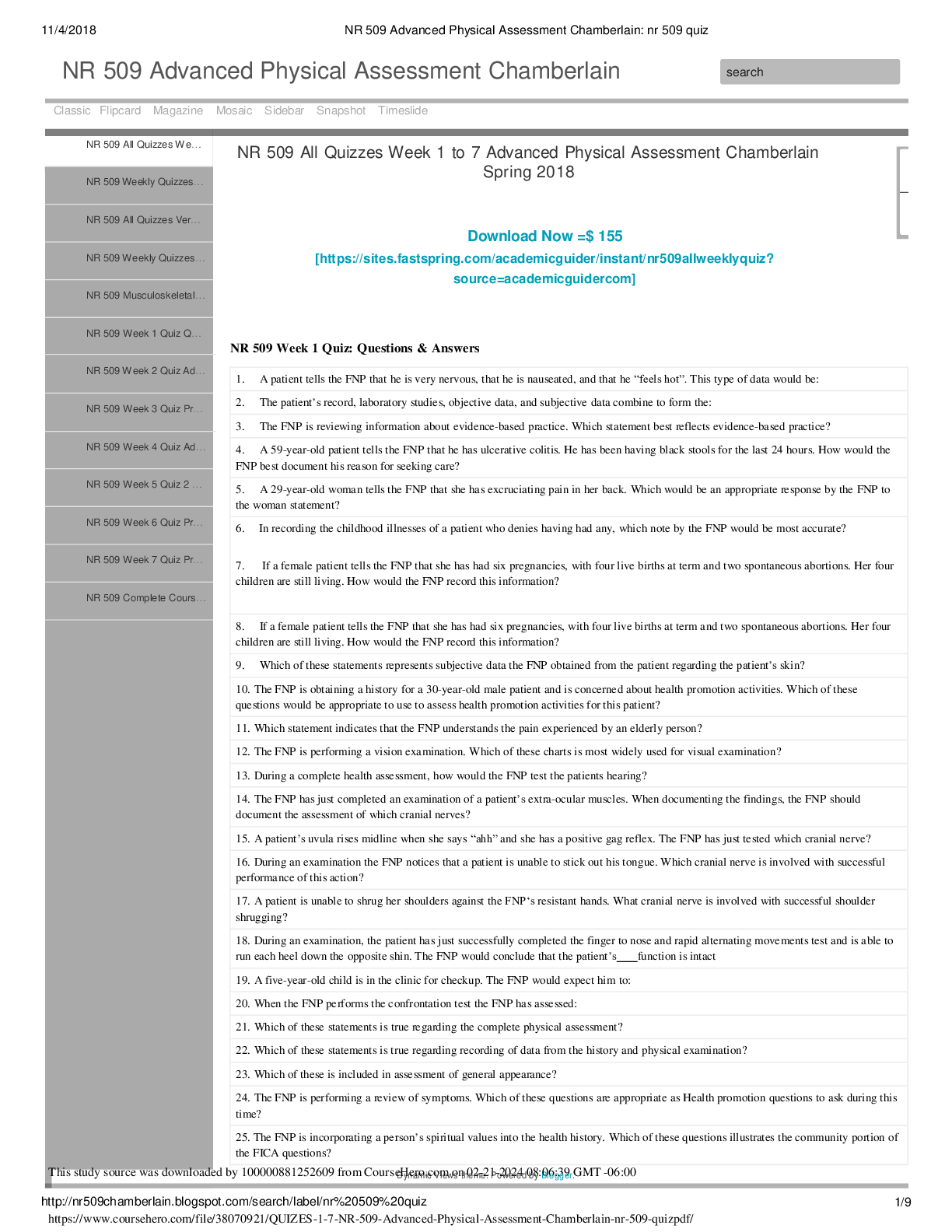
Instant download
Reviews( 0 )
Document information
Connected school, study & course
About the document
Uploaded On
Feb 27, 2024
Number of pages
9
Written in
Additional information
This document has been written for:
Uploaded
Feb 27, 2024
Downloads
0
Views
20
